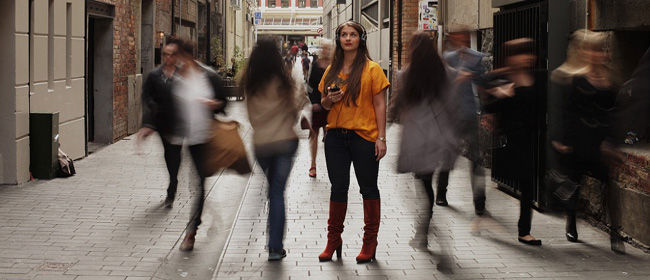
Auckland: City of Culture? [by James Wenley]
I led something of a charmed existence during the 19 days of the Auckland Arts Festival. By night, I could enrich my mind and surrender my senses to the stunning array of local and international shows on offer.
By day, I was En Route, working on a show that sent audience members off, usually on their own, on a magical mystery tour of the Auckland CBD guided by a mobile phone, an iPod, and a few other surprises along the way.
I had reached Festival totality. What a treat. Was I feeling cultured or what!

En Route was developed by four Melbournites, who have worked together as One Step at a Time Like This Productions since 2001, and have designed seasons of their show for ten cities now, including for the London Cultural Olympiad. I was one of 12 Auckland Guardians who met participants at the beginning and end of the route (what we did in between remains a secret!). While One Step make a point of finding local music for their ipod tracks for each of the cities they visit, and spent weeks before the show opened exploring Auckland and designing their route, the Australians were clear that they were not making a show about Auckland itself. Among various things, it is a show about a shift in perspective, of looking, of spaces, of discovery, of the ‘real world’ becoming your stage. [I reccomend this response from Gather + Hunt]
But in chatting to participants afterwards, feedback consistently turned to the city: some mentioned personal connections with places they walked through on their journey, others spoke of growing up in the city and discovering places they had never been through before, others marveled at the transformation Auckland had gone through in recent years. Our post-show conversations invariably took place at Imperial Café on Fort Lane, a symbol for a trendy new Auckland surrounded by shared-use roads that are reclaiming the CBD for the pedestrian over the car.
The central city became my base and home. I was struck by the mass of people in the city all hours of the daytime, bustling and alive. I learnt the regular haunts of the beggars, so too the street performers who livened the atmosphere. En Route found an Auckland growing up, reaching for the Brownian utopia for the world’s most liveable city.
To reach there, of course, Arts and Culture needs to be a player, which is where the big picture of the Auckland Arts Festival comes in. En Route serves as a good metaphor for the role the 2013 Auckland Arts Festival served for her city. En Route was an outside lens in which our city was reflected back to us – and audiences claimed their own experience and narrative. The Auckland Arts Festival reflected back the Auckland of now at amidst a critical moment of cultural consolidation and a city at a crossroads. We’ve long shed the cloak of cultural cringe, and local work like The Factory and Hui were positioned as the backbone of the Festival, standing shoulder to shoulder with international visitors. But we’re still not at a position of cultural championing either. We’re still trying on for size the idea of our nation as an Island of the Pacific. Focused on the Auckland plan, debate continues as to what sort of city we should be in the future. And just where does the Arts fit into it all?
Pacific Ring of Fire
If the Festival had somehow escaped the attention of Aucklanders, it announced itself boldly and loudly with the premiere over three nights of visual firework spectacular The Breath of the Volcano in the “outdoor theatre” of the Auckland Domain. This was a new work from the French Groupe F, who were commissioned by the Festival to create a show for us. Inspired by the symbology of New Zealand, our landscape, and the tectonic forces below, it was a bombastic sensation for the eyes and ears: glittering shards lit up the sky while performers in light suits (swelled by members of local Red Leap Theatre Company) ran along the bank below the Auckland Museum. Alongside the suitably crowd-awing pyrotechnics, there were moments of absurd whimsy projected onto the museum, like giant yellow chicks crossing CBD streets. That iconic red gate, which separates Aucklanders from the waterfront, made an appearance (when will it finally be scaled?). Cartoon frogs scuba-dive before the museum and sky burst into rainbow (a nod to one element of France and New Zealand’s shared history). Familiar native bird sounds provided a soothing and comforting counterpoint to the skyward blasts. If we could make anything from our reflected identity from Volcano it would be a muddled one: a hodgepodge of iconography that tracks something of where we’ve been, if not quite sure where we are going.
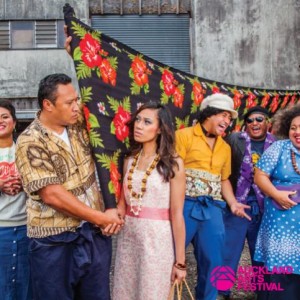
As I wrote in my review of The Factory, “the chance taken on Kila Kokonut’s Krew The Factory– “New Zealand’s first Pacific Musical” – should prove the biggest statement of this year’s Auckland Arts Festival.” It stands an attempt to position the Pacific at the centre. Following a season in Mangere in 2011, the musical about Pasifika factory workers in New Zealand was completely taken apart and put back together for the Festival with new songs, new characters, a new time period (1970s) and a radically new ending.
By focusing on this important historical period in New Zealand and Pacific history, the creatives have been able to push the story towards a wider relevance. The specific brings the universal. It is a story of coming to a new land and the struggle to retain your roots. It is a story of rights and equality. It is a story of cross-cultural love. It’s a potent formula for Musical Theatre and an intentional positioning so that The Factory becomes a story, as Jonathan Alver in a post-show discussion put it, that “audiences all over the world will recognise”. There are big plans afoot, including interest in a film, and Alver is confident that this Musical is “going to go right around the world”. A laudable and not unrealistic goal: at times I could discern the action coming straight out of a Broadway stage.
Under its Festival guise, The Factory – featuring recognizably star crossed lovers from the Factory floor and the Factory office became West Side Story meets Saturday Night Fever with a Pasifika flavour. With an eye to the international market however, there was a loss to the unique spirit of the show that I had seen in Mangere. Making a grab for the centre, the show’s young lovers become the focus, and we lose the life, and culture around the edges. Instead of a show that tells a Niu Sila story with a Musical Theatre spin, we get a show that tells a conventional Music Theatre story with a Niu Sila spin. It’s a crucial distinction. The showmanship and musicality is top class, but the nuts and bolts of the story still needs fine turning.
I however concluded:
The Factory retains its final message that “this place is just a stop on our way home”. In this story, there is no redemption for one-part of the older generation, but instead looks forward to the next generation to make some change, and this message invites reflection about where New Zealand and the Pacific are right now.
It is exciting and exhilarating to have a musical like The Factory to call New Zealand’s own. It’s going to be so fascinating to see where it goes next, and how it goes next. This season of The Factory deserves to be just a stop on a much wider journey.
Next up for the team is The Factory Story – Musical webisodes “ telling the story of a Pacific Island family who compete in a big talent quest amongst South Auckland factories” and set thirty years after The Factory stage show.
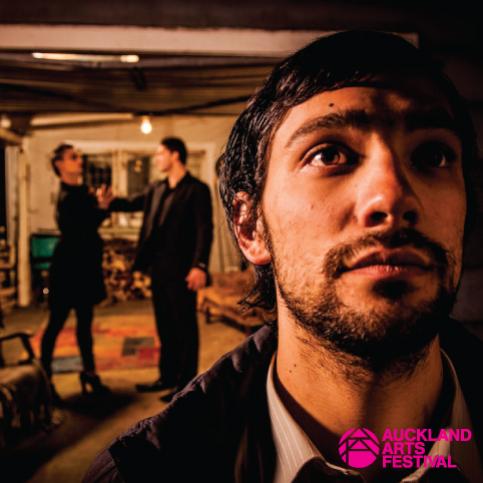
The other preeminent New Zealand theatre work, Hui, directed by Rachel House and produced by Silo, was promoted with the inciting comment from playwright Mitch Tawhi Thomas that “I’m really over that portrayal of Maori onstage as other worldly spiritual types. I’m not dissing our spirituality, but 30 years on from the first Maori appearing onstage, we can now talk about things people were too scared to talk about before”.
Tawhi’s non-mystical Maori is defined by deceased Bob Wahie, whose will records a wish to be cremated rather than the usual maoritanga. His illness and death brings his sons back together, long estranged, to decide what to do with his body. Without tradition, what can you hang on to? The Family unit itself is merely a tradition too: a group collected by blood, but what else ties these brothers together?
The sons make for a progressive cast of Maori character types (and rewarding challenges for actors). There’s the mentally impaired one who remained at home, the transgender, the rugby league star, the former mongrel mob turned Destiny type, but as Matt Baker writes in his review, the writing “successfully avoid[s] any sense of stereotypical portrayal.”
There’s meaty drama indeed as the characters reunite and clash, with a ticking time bomb over their heads in the form of the wider whanau who will soon arrive to claim the body for the marae. There’s a wicked black comedy in here too as the corpse of Wahie remains in his armchair throughout the play. Well almost, for in several beautifully poignant sequences throughout the play dancer Maaka Pepene rises to walk amongst his family, the ghost and memory of his presence living on, curiously suggestive of a connection to a wider spiritual world where the body itself is immaterial. These are stunningly effective pitched theatrical moments.
With elements in play, they didn’t quite congeal for a satisfying last punch at the end. I myself sat in my seat after the show, deflated. Matt writes:
While the conflict and the finale of the play are both dramatically agreeable, there is a lack of catharsis. The execution of the final moment is indeed a surprise, though its arrival is not thanks to Newberry’s silent actions, which allow the audience to arrive at the point moments before him, but a few more hints towards the specifics of the final action injected into the script earlier might have provided stronger pathos. In saying that, there is no need for a yellow ribbon to be tied around this play (and nor is there one), because that’s not how life works. It is a testament to Thomas’ understanding of the complications of relationships, and that there is no choice in who your family is, only in how you deal with them.
Hui opens a difficult conversation about the wishes of the individual over the many or personal choice versus cultural expectation, giving much to chew on after its end.
Familiar and the Exotic
Each time I went to Aotea Square over the Festival, I found myself returning to watch snatches of projected video art When the Gods came down to Earth by Srinivas Krishna, which realises earthbound Indian deities through film special effects. A collage of moving images with a strange soundtrack, mood over narrative, I was transfixed by its sights including Ganesh and the many-headed blue woman. It was unfamiliar, exotic, and would briefly take me out of the Square and the city and into myth.
It was not the only work to offer something a little exotic.
With one eye on the growing Chinese community within Auckland, China’s most successful play Rhinoceros in Love, performed in Mandarin with English surtitles, was a love story unlike any other I had seen and blew my eyes, and mind, wide open.
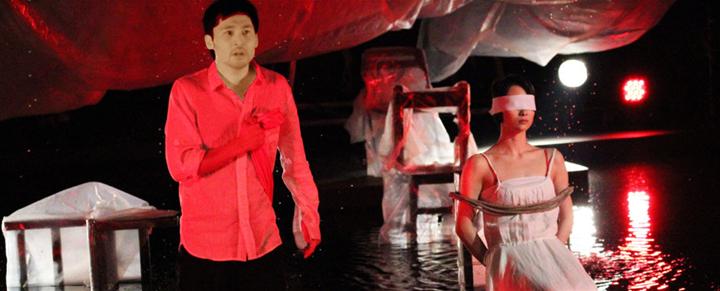
Rhinoceros in Love represents a ground-breaking avant-garde production in Chinese theatre: first performed in 1999, writer Liao Yimei and Director Meng Jinghui rebelled against traditional Chinese theatre convention to create a passionate, youth-driven, eye-popping extravaganza that inspired a generation to learn the play’s words as a “love bible”. Updated to orientate around the current AY Generation (Angry Youth), you can feel the exhilarating tension and reaction against thousands of years of theatre, and of culture.
It was exhilarating to experience theatre with such a distinct point of view, and visual style, with most notably the Maidment Theatre stage being flooded (as it would turn out, a month too early).
The playing style is often declamatory, actors simply facing the audience to deliver their lines, which creates something of an aesthetic elegance. A wider cultural landscape is sketched by the ensemble through song, stylised movement, and scenes from an off-beat point of view. It is a world through Ma Lu’s prism that is not quite sane: he is confounded by a diamond toothbrush salesman who offers two tooth brushes for the price of one, but refuses to sell him just one toothbrush. He takes non-sensical love training classes that provide him no practical help. Mingming makes no sense either: she loves another who mistreats her. Why won’t she accept all that he offers?
Babel at first seems exotic: a remarkable melting pot experiment to put the world on stage as dancers from over the globe come together to create and perform a show using the tower of Babel and language as inspiration, lead by French choreographic stars Sidi Larbi Cherkaoui and Damien Jalet. Instead we find the familiar, and what unites rather than divides us.
The work strips language to its most essential component. The first layer is speech, the cast (in a line) each claiming, in many voices, the strip of stage in which they kneel on. There’s the language of music too: rhythm, beat, harmony, a remarkable fusion of genres played live. Of course there is the language of dance, which one might assume to approach the universal, but in the post-show forum it was remarked that this was the element which caused the most strife amongst the company, with the cast having different cultural approaches to the form.
The company manipulates large metal frames into different shapes and configurations, claiming spaces on the stage. There are misunderstandings, mis-translations, and a beautifully slow but horrific brawl between the company captures the brutality that humanity enacts on itself.
But we also feel the yearning for connection. A Metropolian C-3P0 figure, played by a strikingly tall young lady, is a guide and witness to humanity, and never quite one of them. She introduces the concept of motor neurons, explaining that when we see another person make a movement, neurons in our body are stimulated: a basis for empathy. There’s something in that: as the Babel company dance, our neurons dance along with them. Language begins at the cellular level.
Babel is the undoubtedly the coup of the Festival: high-quality provoking work, mind-seering imagery, and an attempt to build a tower of understanding between each other, and understanding ourselves through others.
Visitors
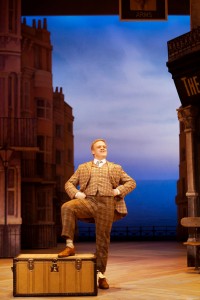
One Man, Two Guvnors from the National Theatre was theatrical blockbuster of the Festival season, which bought the form of commedia dell’arte to a gaudy 1963 Brighton. As I wrote in my review:
One Man, Two Guvnors comes to the Auckland Arts Festival with the international seal of approval, and a hype machine of the ‘funniest show on the planet’ sort. While it cannot live up to these impossible expectations, what it is a good farce done very well indeed. It’s a show that knows what works, and sticks to it. It does not re-invent the wheel, but instead reminds us of what can make commedia and farce so satisfying, and re-energises the form.
There were laughs aplenty, especially generated from Owain Arthur in the updated Harlequin role.
Owain Arthur’s Francis, very much the audience’s man, is given free rein to riff and improv within the structure. The show cheerfully breaks the fourth wall rules, Arthur enjoying playing with audience members so much that he often corpses, breaking into his mad laugh, and encourages the other actors to join him.
In breaking the rules however, and making us think we are in on the joke, there is something very false about this show. And I’m not talking about the artifice of the various set pieces that needed a live skiffle band to play during curtain down set-changes. Humour is generated on false pretences. The belly-aching dinner scene, in which Francis has to serve both of his guvnors without the other realising, escalates with the inclusion of a woman plucked from the audience, who turns out to be a plant when incidents go beyond too far.
Worse is the sandwich gag, which establishes Arthur as an improvisatory genius. Arthur asks if anyone has a sandwich, and right on cue, someone puts up their hand. Who brings a sandwich to the theatre. Who indeed?
Paul Simei-Barton at in his NZ Herald review was very taken by this moment:
Arthur may also be feeling conflicted about the Auckland audience after a bizarre exchange as he launches into a rant about the torments of hunger and theatrically asks: “Has anyone got a sandwich ?”
The show has played to packed houses around the world but I suspect that only in New Zealand would the rhetorical question be answered by the well-intentioned offer of a real plastic-wrapped sandwich.
The typically Kiwi gesture of sharing your sammies was perfectly in tune with the play’s ironic toying with story-telling conventions and the actors took up the challenge with an improvised display of unbridled hostility towards the benefactor who had stolen their limelight.
Problem is, it happened the following night. And the next night. That sandwhich is also a plant. We laugh with the expectation that this is real, and as a genuine spanner in the works for Arthur. These tricks cheapen and diminish the show.
A different sort of fooling went on in Leo, this time for the benefit of both actor and audience. Presented in New Zealand for the second time, the work of Tobias Wegner (actor, dancer, trampolinist, gymnast, and clown) sees him stuck inside a box. On one side of the stage we can watch him live, on the other a live video feed plays with the image turned on its side to give the illusion Wegner has the ability to perform impossible movements. Matt Bakers describes it thus:
The magic of the show is a simple, albeit ingenious, illusion, one which Wegner and director Daniel Brière do not shy away from exposing. In doing so, we, as an audience, choose to both acknowledge and ignore it. Ultimately, we want to be fooled. The transition between live action and video footage (designed by Heiko Kalmbach), which we choose to make at our own discretion, also reinforces the duality of both the theme and the style of piece. There is a great sense of coming full circle, from the first moments in which we spend adjusting to said style, to the finale, where the walls between the two performance spaces are blurred. It is in this finale that Wegner delves into the deeper, darker side of the material, and through it finds the hero’s moment of self-achieved submission. The answer was with him all along; he just had to discover it in his own time.
Meanwhile, for me, the imposed artifice of the storytelling in I ♥ Alice ♥ I got in the way of its own story about two women named Alice who love each other very much:
The conceit of I ♥ Alice ♥ I is that the Alices who tell their story (played by Conroy and Clare Barrett) are aware that they are in the theatre telling their story to the audience. They approach on opposite sides of the stage, nervous and hand-wringing, and state “walk on and start facing the audience”, and repeat the mantra that the audience are their “friends, not enemies”…. The production, and their acting style, is extremely self-conscious: they are even “caught out” by a change in lighting state… Despite the strong and emotive subject matter I had a hard time giving into the show. I found myself constantly watching the very particular performances of Conroy and Barrett. A recording, possibly of the real Alices, in which they remember their first evening together, was quick-witted, warm, and had a palpable sense of ease between them. In front of us however, the Alices seem constantly paralysed, Alice S’s hand-wringing never quite settles, and they act as if it is a real burden to open up to us.
The Spiegeltent once again hosted a season of a cabaret/circus show hybrid, this time Cantina from Australia’s Strut and Fret. There’s a old school vibe within the tent, the company evoking a 1930s style using and twisting tropes from vaudeville or early cinema (the effect of film projection is achieved with a performer rapidly moving their hand in front of a light). There are some rather amazing set pieces, including tight rope walking on heels or even more precarious balancing on champagne bottles. The real appeal of shows like this is to be allowed to be intimate and up close to the performers, but unfortunately I felt removed and disconnected from the experience in a booth at the back of the tent. It didn’t quite reach the height of previous Spiegeltent shows like 2011 Smoke & Mirrors, erring on the side of too tame rather than depraved.
The Strange Undoing of Prudencia Hart from the National Theatre of Scotland, playing at the Bluestone Bar became the sold-out star of the Festival. I would have loved to have said something about it here, but I was among the many who couldn’t get tickets (the Festival in their wisdom cancelled our review allocation – the shows presales were already tracking well!). So, consider this Prudencia my one regret, the one that got away, and it sounded right up my alley too (Robbie Burns, Elvis, Kylie Minogue and Katy Perry say you Simon Wilson? Who would have thought these names would be included in a show with the devil!)
Where to from here?
The Festival should, and did deliver with unforgettable arts experiences that our city was unlikely to get otherwise, both in attracting the big names, and giving support and opportunity to our local artists. But the Festival can also say something about who we are, and where we are going.
What did I see? I caught a glimpse of a city proud to embrace the arts, and proud of the unique things that we could create down here in this part of the Pacific ring. I saw it in the sparks of fire that lit up the domain and the awed cries from the throng of Aucklanders below. I heard it in the soaring vocals of the Factory. But just a glimpse, and the journey continues.
A remarkable opportunity to build on this year was floated when Festival organisers appealed for an extra $400,000 to underwrite a festival next year with the goal of making the biannual event an annual one. Councilors rejected the request, and Richard Nothey suggested that the Festival should pay for it themselves. Brian Rudman’s column on the issue mentions Festival Chairwoman Victoria Carter reported a healthy Festival in the ascendance: double box office sales and triple audiences from 2011.
If higher than expected box office profits are made, or alternative funding is found, than a 2014 Festival can go on, but Rudman says, “No One is really expecting that”. As he concludes, “with the great head of steam the festival has now developed, combined with the seemingly universal support from councilors and bureaucrats for it to become an annual event, it does seem it will be a huge missed opportunity, if the council doesn’t come up with $400,000 now.”
An annual Festival would suggest a very grown up city indeed (here’s looking at you Sydney Festival), and – to put down to paper what everyone is secretly thinking – a good one to have over ‘Arts Capital’ Wellington!
So while work continues, the chances of a Festival next year without further Council support is slim. In the meantime, I treasure my Festival experience of 2013 and dream about the next one. What will we discover about ourselves next time?
READERS: What did the Arts Festival say to you? What were your standout productions? Comment below!

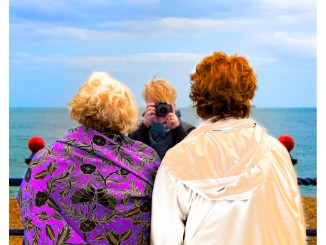
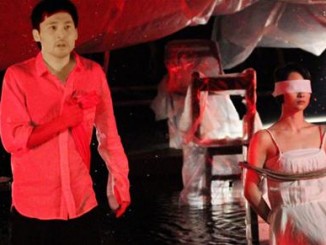
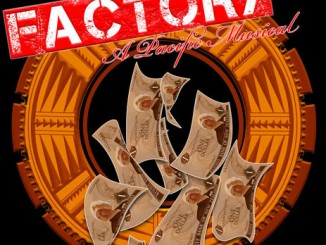
Leave a Reply